
Similar to this research (published by BioMed Central in BMC Medical Informatics and Decision Making), Adaptive sees equal opportunity to inform organizations of not only the benefits of clinical trial interoperability, but also introduce ways to achieve it. For instance, If you are struggling with integration of clinical study data from multiple systems and platforms, Adaptive Clinical Systems offers a simple, secure, validated, compliant, and cost-effective solution for clinical data integration.
The Adaptive eClinical Bus, a cloud-based hosted service, will integrate with your EDC, ePRO, CTMS, Medical Imaging, IVR/IWR, and analytical/data visualization systems to ensure accurate and efficient transfer of clinical data for any study of any complexity.
Click here to learn more about Adaptive’s eClinical Bus solution.
Interested in learning more about the article, “The Value of Structured Data Elements from Electronic Health Records for Identifying Subjects for Primary Care Clinical Trials”? Read below:
Background
An increasing number of clinical trials are conducted in primary care settings. Making better use of existing data in the electronic health records to identify eligible subjects can improve efficiency of such studies. Our study aims to quantify the proportion of eligibility criteria that can be addressed with data in electronic health records and to compare the content of eligibility criteria in primary care with previous work.
Methods
Eligibility criteria were extracted from primary care studies downloaded from the UK Clinical Research Network Study Portfolio. Criteria were broken into elemental statements. Two expert independent raters classified each statement based on whether or not structured data items in the electronic health record can be used to determine if the statement was true for a specific patient. Disagreements in classification were discussed until 100 % agreement was reached. Statements were also classified based on content and the percentages of each category were compared to two similar studies reported in the literature.
Results
Eligibility criteria were retrieved from 228 studies and decomposed into 2619 criteria elemental statements. 74 % of the criteria elemental statements were considered likely associated with structured data in an electronic health record. 79 % of the studies had at least 60 % of their criteria statements addressable with structured data likely to be present in an electronic health record. Based on clinical content, most frequent categories were: “disease, symptom, and sign”, “therapy or surgery”, and “medication” (36 %, 13 %, and 10 % of total criteria statements respectively). We also identified new criteria categories related to provider and caregiver attributes (2.6 % and 1 % of total criteria statements respectively).
Conclusions
Electronic health records readily contain much of the data needed to assess patients’ eligibility for clinical trials enrollment. Eligibility criteria content categories identified by our study can be incorporated as data elements in electronic health records to facilitate their integration with clinical trial management systems.
Interested in The Value of Structured Data Elements from Electronic Health Records for Identifying Subjects for Primary Care Clinical Trials?
Want to read the full article by Mohammad B. AteyaEmail author, Brendan C. Delaney and Stuart M. Speedie?
BMC Medical Informatics and Decision Making201616:1
DOI: 10.1186/s12911-016-0239-x© Ateya et al. 2016
Received: 27 May 2015Accepted: 6 January 2016Published: 11 January 2016
